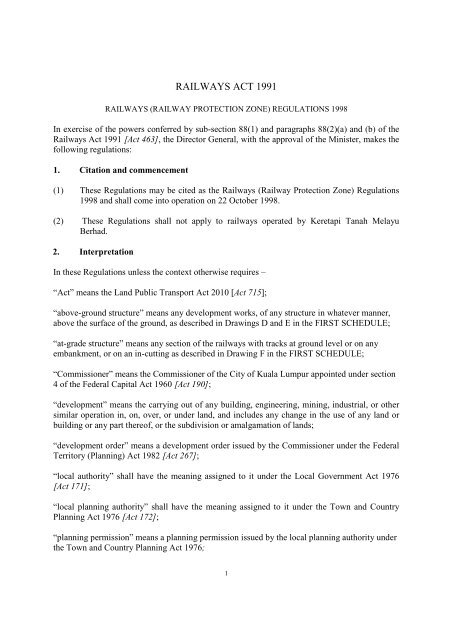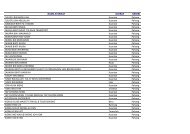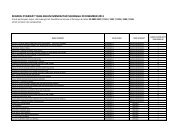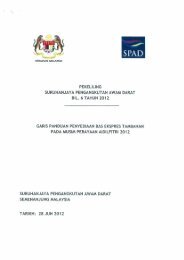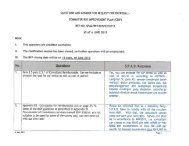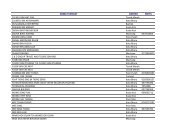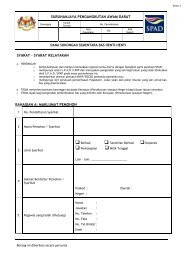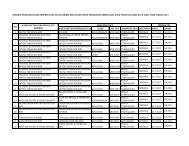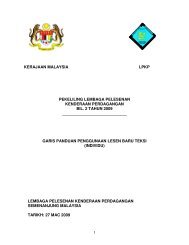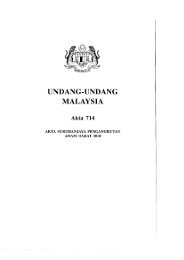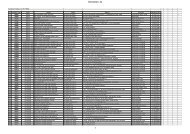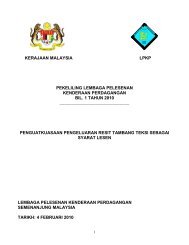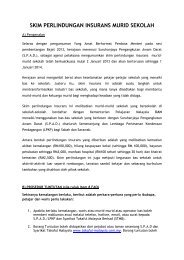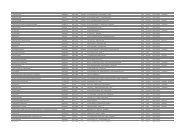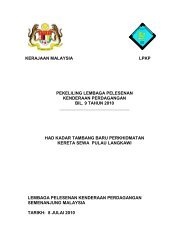RAILWAYS ACT 1991 - SPAD
RAILWAYS ACT 1991 - SPAD
RAILWAYS ACT 1991 - SPAD
You also want an ePaper? Increase the reach of your titles
YUMPU automatically turns print PDFs into web optimized ePapers that Google loves.
<strong>RAILWAYS</strong> <strong>ACT</strong> <strong>1991</strong><strong>RAILWAYS</strong> (RAILWAY PROTECTION ZONE) REGULATIONS 1998In exercise of the powers conferred by sub-section 88(1) and paragraphs 88(2)(a) and (b) of theRailways Act <strong>1991</strong> [Act 463], the Director General, with the approval of the Minister, makes thefollowing regulations:1. Citation and commencement(1) These Regulations may be cited as the Railways (Railway Protection Zone) Regulations1998 and shall come into operation on 22 October 1998.(2) These Regulations shall not apply to railways operated by Keretapi Tanah MelayuBerhad.2. InterpretationIn these Regulations unless the context otherwise requires –“Act” means the Land Public Transport Act 2010 [Act 715];“above-ground structure” means any development works, of any structure in whatever manner,above the surface of the ground, as described in Drawings D and E in the FIRST SCHEDULE;“at-grade structure” means any section of the railways with tracks at ground level or on anyembankment, or on an in-cutting as described in Drawing F in the FIRST SCHEDULE;“Commissioner” means the Commissioner of the City of Kuala Lumpur appointed under section4 of the Federal Capital Act 1960 [Act 190];“development” means the carrying out of any building, engineering, mining, industrial, or othersimilar operation in, on, over, or under land, and includes any change in the use of any land orbuilding or any part thereof, or the subdivision or amalgamation of lands;“development order” means a development order issued by the Commissioner under the FederalTerritory (Planning) Act 1982 [Act 267];“local authority” shall have the meaning assigned to it under the Local Government Act 1976[Act 171];“local planning authority” shall have the meaning assigned to it under the Town and CountryPlanning Act 1976 [Act 172];“planning permission” means a planning permission issued by the local planning authority underthe Town and Country Planning Act 1976;1
“portal structure” or “transition structure” means any guideway structure that occurs between anunderground structure and above-ground structure or at-grade structure as described in DrawingC in the FIRST SCHEDULE;“railway protection zone” means the railway protection zone designated by the Director Generalpursuant to regulation 3;“railway structure” includes the above-ground structure, the at-grade structure, the undergroundstructure and the portal structure;“restricted activities” means the activities described in the THIRD SCHEDULE which couldpose safety hazards on the railway structure and the operation of the railway;“restricted activities standards” means the safety standards for restricted activities prescribed bythe Commission in the THIRD SCHEDULE;“safety standards” means such safety standards prescribed by the Director General in theSECOND SCHEDULE; and“underground structure” means any development works of any structure in whatever manner,below the surface of the ground as described in Drawings A and B in the FIRST SCHEDULE.3. Designation of railway protection zoneThe Director General shall designate an area in the railway premises as a railway protectionzone, as described in Drawings A to F in the FIRST SCHEDULE.4. Issuance of development order or planning permission after consultation with theDirector General(1) The Commissioner or any local planning authority should consult with the DirectorGeneral before issuing a development order or planning permission regarding anydevelopment in the railway protection zone.(2) If the consultation in sub-rule (1) is not carried out, such failure shall not impede inwhatsoever manner the Commissioner or any local planning authority from issuing suchdevelopment order or planning permission.5. Permission for restricted activity after consultation with the Director General(1) A local planning authority should consult with the Director General before allowing anyrestricted activity to be carried out in the railway protection zone.2
(2) If the consultation in sub-rule (1) is not carried out, such failure shall not impede inwhatsoever manner the local planning authority from allowing any restricted activity tobe carried out.6. Matter to be taken into cognisance before issuance of development order orplanning permission or permission for restricted activityThe Director General shall ensure that the Commissioner or the local planning authority, as thecase may be, prior to the issuance of the development order or the planning permission, and thelocal authority, prior to allowing a restricted activity to be carried out, in the railway protectionzone take cognisance of –(1) the railway protection zone;(2) all maps and drawings provided by the railway company;(3) any possible effect on the safety of the railway structure or the operation of the railway asa re-suit of the development or the carrying out of the restricted activities; and(4) the safety standards and the restricted activities standards.7. Compliance by Director GeneralFor the purposes of rule 6, the Director General shall –(1) at all times provide the Commissioner or the local planning authority with the safetystandards; and(2) cause the railway company to prepare and provide the Director General such maps anddrawings indicating the sites and positions of the railway structures.8. Director General may recommend for suspension or cessation of developmentSubject to any laws for the time being in force pertaining to the suspension or cessation ofdevelopment, the Director General may make such necessary recommendation to theCommissioner or the local planning authority or such relevant authority, for the suspension orcessation of the development of the carrying out of the restricted activities, or to take anyappropriate measure, upon the Director General being satisfied that –(1) the safety of any person using the railway is or has been or may be affected; and(2) the safety of the railway structure or the operation of the railway is or has been or may beaffected,as a result of the said development or the carrying out of the restricted activities.3
9. Application not retrospectiveThese Regulations shall not apply retrospectively.4
1. Underground and portal structuresSECOND SCHEDULE(Regulation 3)SAFETY STANDARDS(1) Drawings A, B and C in the FIRST SCHEDULE define the first and second reservearound underground and portal structures as indicated in the drawings. The followingrestrictions shall apply in each reserve, and are equally applicable to the constructionactivities below the tunnel alignment and portal:(a)(b)(c)(d)(e)(f)(g)the pressure on the underground structures shall not be increased due to filling ordewatering or form additional loads transmitted by foundations (including loadsarising during construction) without prior approval of the Director General;where dewatering works or pumping from any trench, excavation, caison, pile orwell is more than 5 metres deep, precautions such as reasonable cut-off underexcavations are to be taken and suitable instrumentation installed to monitor porepressure changes and ground settlement both close to the works and to the nearestrailway structure. Dewatering/pumping plans shall demonstrate the effect ofdrawdown to the stability of the tunnel or underground structure;where excavations, trenches, caissons, piles or wells are less than 5 metres belowthe ground surface, pumping of water from them may be allowed by theCommission;where tunnel construction is permitted, precautions must be taken to avoid waterflow into railway tunnels at the face, or through the temporary or permanentlinings. Suitable instrumentations shall be installed. Tunnelling involving use ofcompressed air shall be restricted, with specified plans and methods subject to theDirector General’s prior approval;where basements are more than 5 metres below ground surface, they shall bemade as watertight as possible. The base slab and walls shall be designed towithstand full hydrostatic pressure, and pressure relief in the form of weep-holesor under-drains is not allowed;differential movement resulting from the works shall not produce final distortionin the track or its plinth in excess of 3 milimetres in 6 metres (1:2000) in anyplane or a total movement in the railway structure or tracks exceeding 15millimetres in any plane;the piezometric pressure in compressible soils shall not be reduced by more than10 kilopascal. Where the total depth of compressible soil is less than 15 metres5
and the railway structure is supported below the compressible soils, then thisrequirement may be waived by the Director General;(h)(i)the peak particle velocities at any railway structure resulting from blasting or formdriving or with-drawing of piles or any operation which can induce prolongedvibration which shall not exceed 15 millimetres per second; anddemolition of existing structures shall be controlled to ensure no shock orvibration damage to the underground structures.(2) The following restrictions shall apply in the first reserve:(a)(b)(c)(d)no sheetpiles, piles, foundations, boreholes or wells shall be driven within thiszone;no excavation greater in depth than 3 metres or within 3 metres vertically of therailway structure shall be permitted. No dredging greater than 1.5 metres shall beundertaken in the river where the tunnel alignment is under the river;no blasting shall be permitted; andhorizontal tie-backs and ground anchors extending into the first reserve shall bedesigned such that no part of an anchor is closer than 3 metres to any undergroundor transition structure. The centroid of the fixed length of the anchor should bemore than twice the fixed length away from any underground or transitionstructure. Tie-backs and anchors shall not be subject to testing which results incollapse and/or failure in the soil structure surrounding it.(3) The following restrictions shall apply in the second reserve:(a)pile foundations may generally be constructed in the second reserve subject to thefollowing requirements:(i)(ii)(iii)the clear distance between the outside of the pile and the outside of theunderground of transition structure is greater than 3 metres or 5 pilediameters whichever is the greater;the piles are designed so that they are debonded within the zone ofinfluence of the underground structure and develop all of their load eitherin shear or end bearing from soil located below the zone of influence ofthe structure;piles shall generally be constructed by auger or reverse circulation drillingtechniques and the stability of the ground ensured by the use of casingsand/or drilling muds as may be appropriate;6
(iv)(v)the use of percussively driven concrete piles, sheetpiles, steel H-Piles ortimber piles, or the use of rock chopping chisels are not acceptable within10 metres of the structure; andthe use of vibratory method of installing sheetpiles, H-piles or casings isprohibited;(b)(c)(d)site investigation bore holes may generally be drilled in this zone subject toverification of the exact location of the underground structure on site. All suchboreholes shall be carefully and completely grouted to their full depth with abentonite / cement grout on completion;basement excavations and foundations are generally acceptable subject to therequirements of paragraphs 1(1)(a) to (i); andno blasting shall be permitted.(4) Site investigation reports and data shall be copied to the Director General for reference.(5) Details of any proposed pressure grouting method of soil improvement (jet grouting,injection grouting, grouting freezing, lime or cement stabilization, etc) shall be submittedto the Commission for approval, and each shall be considered on a case-by-case basis.2. Above-ground structures(1) Drawing D in the FIRST SCHEDULE defines acceptable limits on excavations andground surcharge adjacent to pile caps supporting above-ground structures. Thefollowing requirements shall apply:(a)(b)(c)excavation above pile caps is acceptable;no excavation shall extend below a line drawn at a gradient of 1:1 from the topsurface of the pile cap structure as shown in Drawing D in the FIRSTSCHEDULE;no surcharge on the earth surface shall extend above a line drawn at a gradient of1:1 from a point on ground surface located at the intersection of the groundsurface with a line extended from the maximum depth of foundation pile on 1:1gradient outwards;(d) where the depth of compressible soil, as defined in paragraph 1(1)(g) exceeds 15metres, then the piezometric pressure at 5 metres depth adjacent to the pile capshall not be lowered by more than 1 metre;7
(e)no building shall be constructed within 6 metres of any above-ground structuremeasured from the outer edge of the above-ground structure unless it conforms tothe following:(i)(ii)(iii)(iv)(v)(vi)(vii)development shall not exceed one storey;development shall have no basement;the development shall be of non-combustible construction and shall have afire-resistance rating for its elements of structure of not less than 2 hours;at least 1 metre clearance (shown ‘x’ on Drawing E in the FIRSTSCHEDULE) from top of the development’s roof to underside of theabove-ground structures beam shall be maintained. No projection abovethe surface of this roof shall be allowed. Development roofs shall beconstructed such that above-ground structures access holes areinaccessible from them;all structures shall be kept at least 0.5 metre clear from the edge of thepilecaps or 2 metres clear from the edge of the bearings whichever is themore restrictive (shown ‘y’ and ‘z’ respectively on Drawing E in theFIRST SCHEDULE);activities carried out shall be of low fire risk;no use of piped gas and/or bottled gas shall be allowed;(viii) no development is allowed to be built around or to enclose any abovegroundstructures column. All sections of above-ground structures shall bekept accessible to maintenance and vehicles;(ix)(x)(xi)the development shall be protected by approved automatic sprinklersystem, if so required by the Director General;surface and roof run off from the development shall not interfere with theexisting above-ground structures drainage system. The applicant shall bearall costs and expenses incurred in the diversion and reinstatements of thedrains; andexposed lightning conductor running along the surface of the abovegroundstructures column shall be protected.(2) For the purpose of these Regulations, the Director General may allow a modification tothese Regulations provided that the applicant justifies, at the Director General’ssatisfaction:8
(a)(b)that all measures and dispositions are taken for preserving the level of the originalwater table if any, for avoiding any lateral displacements in the surrounding soilstrata as well as its bearing and shearing capacities; andthat all measures and dispositions are taken for preserving the existent bearing andfriction capacities of adjacent foundations, and for avoiding any movement ofexisting adjacent structures in any plane.3. At-grade structures(1) Drawing F in the FIRST SCHEDULE defines the limits of the first and secondreserve that exist around the at-grade structures.(2) Paragraphs 1(1)(b) to (h) shall apply to engineering works in each reserve.(3) Generally no engineering work of any kind will be allowed in the first reserve.(4) Piled foundations will generally be permitted in the second reserve subject toregulation 6.(5) Site investigation boreholes may be drilled in the second reserve subject toregulation 6.(6) No trench or other excavation more than 2 metres deep shall be allowed withoutprior written permission of the Director General.(7) No surcharge exceeding 40 kilopascal shall be allowed without prior writtenpermission of the Director General.(8) No surcharge resulting in an increase in ground pressure exceeding 15 kilopascalshall be permitted.(9) The use of high displacement driven piles including timber piles and precastconcrete piles shall not be permitted.(10) The use of water in the drilling of bored piles or site investigation boreholes shallnot be permitted.(11) Site investigation boreholes must be backfilled with cement/bentonite grout.Drains and water pipes shall be designed to avoid raising the groundwater level inthe second reserve.(12) The installation of recharge walls or soak-aways shall not be permitted.4. Building developments adjacent to vents / vent shafts9
To minimise the possibility of contamination of the railway station by fire or smoke, no buildingopening within the development shall be located closer than 5 metres to any vent or vent shaftsirrespective of whether it is free standing or is accommodated in the development. This distancemay be reduced to 2.5 metres provided that the intake air to the vent or vent shafts is directedaway from the building opening and the Director General is satisfied that discharge from theopening is not likely to be drawn by natural convention into the railway station.1. Restricted activities structuresTHIRD SCHEDULE(Regulation 2)RESTRICTED <strong>ACT</strong>IVITIES(1) The following are defined as restricted activities:(a)(b)the erection of scaffolding, maintenance towers, hoardings, fencing, gantries,signs, lighting posts and similar structures where any part of that structure iswithin 6 metres on plan of above-ground, at-grade, portal structure, or ventilationshafts;the operation or movement of cranes, whether fixed or mobile, hoists, ladders,drilling and piling equipment, excavators and any other mechanical equipment orvehicles where any part of the said equipment or vehicle at any stage of its worksis within 6m on plan of an aboveground, at-grade, or portal structure. The term“movement” in this paragraph does not include the passage of the equipment orvehicles along a public roadway. The operation of any equipment or vehicles ofthe fire service shall be excluded;(c) the movement of any vehicle or trailer exceeding 5.3 metres in height within 6metres on plan of an above-ground, or at-grade structure, unless minimum /maximum clearances are posted otherwise;(d)(e)(f)(g)the storage of materials, either loose, in pallet, or in containers within 6 metres onplan of an above-ground, portal or at-grade structure;the storage of Class I flammable and Class II Class III combustible liquids asdefined under the NFPA code of practice and the storage of related pipeworkwithin 30 metres on plan of any above ground, at-grade or underground structure;the storage of explosive materials within 30 metres on plan of any structure aboveor below ground or within 30 metres of any railway property; andthe planting of trees within 6 metres on plan of an above-ground, at-grade orportal structure or within the first reserve of underground structures.10
(2) The standard restricted activity to be complied for the restricted activity stated inparagraph 1(1)(a):(a) any part of the scaffolding that extends above the level of track shall be at least 3metres clear on plan of the above-ground, or at-grade structure;(b)(c)(d)(e)the scaffolding shall be so designed and positioned so that it is not possible forpersons to climb onto any above-ground or at-grade structure;the scaffolding, etc, is sufficiently robust and maintained to a satisfactory,standard so as to prevent collapse onto, obstruction of or danger to the railwaystructures;where deemed necessary by the Director General additional protection measuresshall be provided to the railway, at the applicant's expense;the scaffolding etc shall not interface with the free flow of air into or out ofventilation shafts, ducts or grilles.(3) The standard restricted activity to be complied for the restricted activity stated inparagraph 1(1)(b):(a)(b)(c)the jib of any lifting appliance or any other moving or stationery part of themechanical equipment including its handled load shall not encroach within 3metres on plan from the edge of the nearest above ground or at-grade structureunless the equipment restricted to work beneath the above-ground structures;where deemed necessary by the Director General effective measures of protectionto the above-ground or at-grade structures;the equipment and, where appropriate its foundation has been certifiedsatisfactory for operation within the preceding two weeks prior to the applicationto the local authority.(4) If the standard restricted activity in paragraph 1(3)(a) is not complied with, the DirectorGeneral may consider giving permission for the use of the equipment only during theperiod when trains are not running.(5) The standard restricted activity to be complied for the restricted activity stated inparagraph 1(1)(d):(a)(b)storage is not closer than 2 metres from any above-ground, at-grade, or portalstructure;storage does not impose a load on the railway structure in excess of 15 kilopascal;11
(c)(d)storage is not higher than 4 metres or such that a person may be able to climb ontothe above-ground or at-grade structures from the stored materials;material stored is of low combustibility.(6) The standard restricted activity to be complied for the restricted activity stated inparagraph 1(1)(e):(a)(b)(c)(d)(e)(f)(g)storage is not closer than 7.6 metres from the outer wall of the undergroundstructure;storage tanks containing Class I flammable liquids and Class II combustibleliquids shall be installed underground in a cast-in-place reinforced concrete vaultlarge enough to hold and retain the entire contents of the tanks. The storage tankshall be completely encompassed by not less than 600 millimetres thick of whilewashedsand;vaults, tanks and piping shall be protected from corrosion and have approvedcathodic protection;the tank and all related piping shall conform to the provisions of NFPA 30 and thelicensing requirements of the local authority;storage of Class II combustible liquids may be located above ground. The storagetank shall be placed within a masonry or welded steel, oil-tight vault, of adequatecapacity to contain the contents of the tank. Masonry vaults shall be at least 150millimetres thick and steel vaults shall be made of not less than 18 gauge metal;dispensing pumps for Class II flammable liquids and Class II combustible liquidsshall not be located less than 7.6 metres from the face of such pump to the nearestside of any ventilation shafts opening or station entrance;the surface around the dispensing area whether with or without dispensing pumpsshall be granded in a manner to direct any possible spills into a drain that flowsaway from the underground structures.2. Planting of trees.(1) No trees with full grown heights of more than 7 metres shall be planted within 6 metresfrom the edge of any above-ground or at-grade structure.(2) Whenever required by the Director General, trees planted near to above ground or atgradestructures shall be pruned by applicant such that the outer extremity of the canopyof the tree shall not encroach within 4 metres of the edge of the above-ground or at-gradestructures.12
DRAWING A: Bored TunnelRAILWAY PROTECTION ZONESECONDRESERVEFIRST RESERVESECONDRESERVEExisting GroundLevelDEPTH D145 o6mTypically 12m6mDEPTH D245 oRAILLEVELTUNNEL AXISLEVEL6m6mRAILLEVELTUNNEL AXISLEVEL
DRAWING B: Cut & Cover Tunnel OR Underground StationRAILWAY PROTECTION ZONE(D 1 -3) m OR10m whicheveris greaterFIRST RESERVE(D 2 -3) m OR 10mwhichever is greaterSECONDRESERVEVARIESSECONDRESERVEDepth (D1) m3m Existing3mGroundLevel45 o45 oZone ofInfluenceDepth (D2) m
Drawing C: Transition StructuresRAILWAY PROTECTION ZONESECONDRESERVEFIRST RESERVESECONDRESERVE(10m)3m3m(10m)ExistingGround Level45 o45 o
Drawing D: Above-ground StructuresRAILWAY PROTECTION ZONEFIRST RESERVESECONDRESERVE6m6mSECONDRESERVE(VARIES)(VARIES)Existing GroundLevelPILE CAP1111MAX. PILE DEPTH
DRAWING EABOVE GROUND STRUCTURESVARIESVIADUCTABOVE6m6mAZYxVIADUCTCOLUMNAVIADUCT BEARINGABOVEBUILDING LINE OFFUTURE DEVELOPMENTUNDER VIADUCTSection A-APILECAPBELOWPLANTHIS DRAWING SHOWS BROAD CATEGORIES OF RESTRICTIONS NEEDEDTO PROTECT THE LRT STRUCTURES. REFER TO THE REGULATIONS FORDETAILS
DRAWING F: AT-GRADE STRUCTURESSECOND RESERVEFIRST RESERVE (VARIES)SECOND RESERVE6mLIMIT OF STRUCTURE6mOutsidefence/ wallNO ENGINEERINGWORKS NORMALLYPERMITTEDOutsidefence/wallExisting GroundLevelEMBANKMENTSSECONDSECONDRESERVEFIRST RESERVE (VARIES)RESERVE6mLIMIT OF STRUCTURE6mOutsidefence/ wallNO ENGINEERING WORKSNORMALLY PERMITTEDOutsidefence/ wallExistingGround LevelCUTTINGSTHIS DRAWING SHOWS BROAD CATEGORIES OF RESTRICTIONS NEEDEDTO PROTECT THE LRT STRUCTURES. REFER TO THE REGULATIONS FORDETAILS


